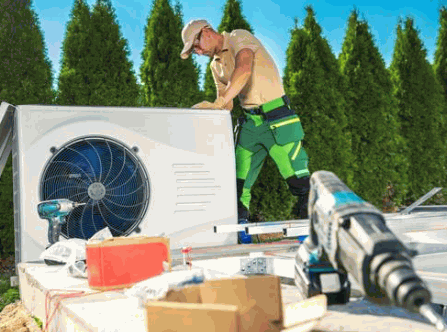Are you contemplating a more efficient heating solution for your residence? An air source heat pump, especially a cold climate heat pump, maybe the ideal option for you. This advanced technology provides substantial energy savings, with improved heating and cooling capacities, especially in cold climates, and is environmentally sustainable, making it a favored choice among homeowners. This article will examine the concept of an air source heat pump, its operational mechanisms, and the numerous advantages it offers. Additionally, the costs related to installation and maintenance will be analyzed to ensure that you are thoroughly informed before making this significant investment.
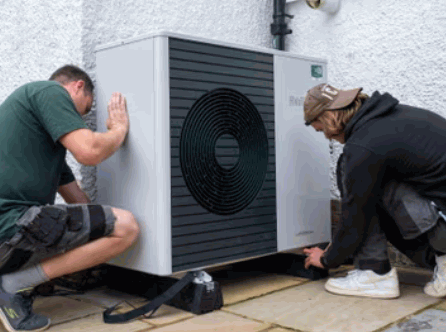
What Is An Air Source Heat Pump?
An air source heat pump represents a sophisticated heating and cooling system that extracts heat from the external environment, even in colder climates, to deliver efficient temperature regulation for residential and commercial properties.
These systems are especially effective in areas such as Denver, where their seasonal energy efficiency energy savings and cooling capacity ratings can lead to a substantial reduction in energy consumption. Leveraging the principles of thermodynamics, air source heat pumps function effectively as both heating and cooling solutions, rendering them a versatile component of any residential or commercial HVAC system.
Learn more: How Does Air Source Heat Pump Work In Winter
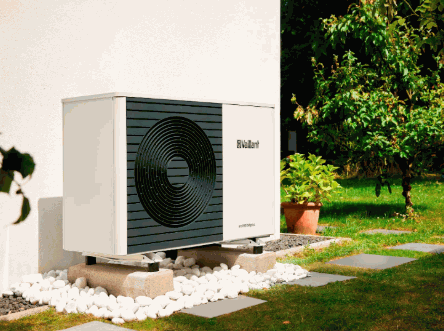
How Does An Air Source Heat Pump Work?
An air source heat pump functions by transferring heat between the indoor and outdoor environments through a refrigerant cycle that absorbs heat from the external air and releases it indoors during the heating process. This cycle is facilitated by key components, including the compressor, evaporator, and condenser, which work in tandem to provide both heating and cooling functions, thereby achieving significant energy efficiency.
The process commences with the evaporator, which absorbs ambient heat from the outside air, even at low temperatures. This absorbed heat causes the refrigerant to change from a liquid to a gaseous state. The gaseous refrigerant then proceeds to the compressor, which increases its pressure and temperature, preparing it for the subsequent stage.
Following this, the hot, pressurized gas enters the condenser, where it releases its heat into the indoor space, returning to a liquid state. This closed-loop cycle is essential for maintaining indoor comfort.
In terms of performance, these systems are typically evaluated using metrics such as HSPF (Heating Season Performance Factor) and SEER, a measure of a system’s cooling capacity (Seasonal Energy Efficiency Ratio), which reflect their energy efficiency and overall cooling capacity.
- HSPF: Indicates heating efficiency.
- SEER: Measures cooling efficiency.
These ratings offer valuable insights for users aiming to minimize energy costs while maximizing comfort, ultimately influencing choices around installation cost considerations.
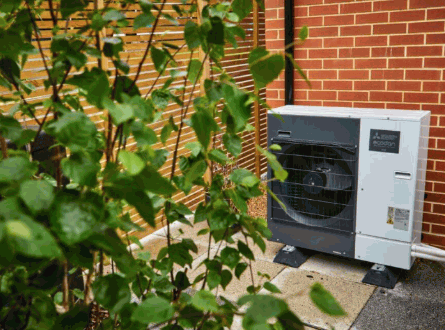
What Are The Benefits Of Installing An Air Source Heat Pump?
The installation of an air source heat pump presents a range of benefits for homeowners and property owners, including improved energy efficiency, substantial cost savings on utility expenses, and a diminished carbon footprint, aligning with Energy Efficiency Program efforts.
These systems offer versatile heating and cooling capabilities, particularly through mini-split heat pump systems, rendering them appropriate for diverse climates, including those in colder regions. Additionally, homeowners can capitalize on available tax credits, including the Energy Efficient Home Improvement tax credit and energy efficiency programs provided by local utilities such as Xcel Energy.
Energy Efficiency
One of the primary advantages of an air source heat pump is its enhanced energy efficiency compared to traditional heating systems, which can result in significant energy savings over time. These systems are designed with high-efficiency ratings, such as the Heating Season Performance Factor (HSPF) and the Seasonal Energy Efficiency Ratio (SEER), contributing to lower utility bills and a minimized environmental impact.
Energy efficiency ratings serve as essential indicators for consumers seeking to reduce their carbon footprint while optimizing energy consumption. When evaluating air source heat pumps, the HSPF and SEER ratings are critical metrics. An air source heat pump with an HSPF of 10 or higher and a SEER of 15 or greater markedly outperforms conventional heating alternatives. Research indicates that households utilizing these pumps can experience savings of up to 30-50% on annual heating and cooling costs.
For instance, a residential account in the Midwest reported a decrease in monthly utility bills by £150 after transitioning to an energy-efficient model. Additionally, a study conducted by the Department of Energy demonstrated that homes equipped with effective heat pumps can achieve energy bill reductions of approximately £200-£400 annually.
By comprehending these ratings and potential savings, consumers can make informed decisions that yield both economic advantages and contributions to environmental sustainability.
Cost Savings
Investing in an air source heat pump can yield significant cost savings attributable to its lower operational costs and potential eligibility for tax credits that can offset the initial installation expenses. Homeowners can anticipate a reduction in monthly energy costs, thereby making the upfront investment more manageable over time.
When evaluating the financial considerations, it is crucial to compare the installation costs and long-term savings associated with an air-source heat pump against traditional heating systems, such as gas or electric furnaces. The initial upfront cost for a heat pump typically ranges from £2,500 to £6,000, depending on the specific system and installation requirements. This expense can be alleviated by various incentives.
- Tax credits and rebates that are often available may significantly reduce the upfront costs.
- Homeowners may recover their investment within five to ten years due to considerably lower energy bills.
- Conversely, traditional heating systems generally incur higher operational costs and necessitate frequent maintenance, thereby increasing their financial burden over time.
Although the initial cost of installing an air source heat pump may appear daunting, its long-term financial benefits and potential savings render it a prudent choice. Homeowners should carefully assess these factors, including the experience of their contractor and any necessary insulation upgrades, when making their decision.
Environmentally Friendly
Air source heat pumps are recognized as environmentally friendly solutions due to their utilization of renewable energy sources, resulting in a significantly lower carbon footprint when compared to conventional heating methods. By maximizing energy efficiency, these systems offer a sustainable option suitable for both residential and commercial applications.
Plus their fundamental design, air source heat pumps contribute significantly to environmental sustainability by minimizing greenhouse gas emissions. Unlike traditional heating systems that frequently depend on fossil fuels, these pumps leverage ambient air, converting it into useful heat with considerably reduced energy input. This capability allows them to provide a clean and reliable source of warmth without exacerbating climate change. The technology’s focus on energy efficiency and heating capacity is vital for promoting eco-friendly practices within communities.
The key benefits of air-source heat pumps include:
- Reduced reliance on carbon-intensive energy sources.
- Lower energy costs for homeowners and businesses.
- Incentives for integration into energy-efficient home improvement programs.
As more individuals and organizations adopt these systems, the cumulative positive impact on the environment can be substantial, paving the way toward a more sustainable future.
Versatility
The versatility of air source heat pumps, particularly mini-split systems, enables them to deliver both heating and cooling solutions within a single unit, making them suitable for a wide array of residential and commercial applications. This is particularly effective in managing electrical panel load requirements. This functionality ensures effective climate control throughout the year, irrespective of external temperature conditions.
These systems are distinguished by their ability to operate efficiently in diverse climates, ranging from humid summers to frigid winters, maintaining optimal heating system performance. Their compact design facilitates straightforward installation, even in scenarios where traditional ductwork may present challenges.
A significant advantage of mini-split heat pumps is their zoning capability, allowing homeowners to regulate temperatures in individual rooms. This feature contributes to energy savings and customized comfort.
They are particularly advantageous in:
- Older homes where retrofitting ductwork is impractical
- New constructions that prioritize modern energy efficiency
- Commercial spaces that require flexible heating and cooling options
Consequently, the adaptability of these systems renders them appropriate for a variety of applications, effectively meeting the needs of users across different environments.
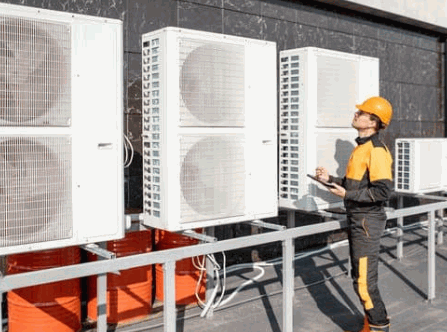
What Are The Factors That Affect The Cost Of Installing An Air Source Heat Pump?
When considering the installation cost of an air source heat pump, various factors can influence the final price. These include the size and heating capacity of the unit, necessary insulation upgrades, potential modifications to the electrical panel or electrical sub-panel, and the contractor experience involved. Brands like American Standard, Carrier, Goodman, Rheem, and Trane offer models with varying specifications and efficiency ratings, all contributing to the overall heat pump cost.
The cost of installing an air source heat pump can vary considerably based on several critical factors, including the type of heat pump selected, local installation expenses, and required upgrades to existing systems, such as the electrical panel and insulation.
It is important for homeowners to understand these factors in order to effectively budget for their HVAC system installation and consider potential savings from the Energy Efficient Home Improvement tax credit.
Size Of The Heat Pump and Efficiency Ratings
The size of the heat pump is a critical factor influencing both installation costs and overall efficiency, as it must be appropriately matched to the heating and cooling capacity requirements of the space it serves. Considering the British thermal units (BTUs) needed is essential for selecting the right size. An inadequately sized system can result in inefficient operation and increased energy costs.
The correct size of a heat pump is instrumental in its effective operation, impacting both comfort levels and utility expenses. When determining the necessary capacity, it is essential to perform a comprehensive assessment that considers variables such as insulation quality, total square footage, and climate zone. Employing methods such as Manual J calculations is recommended for accurate sizing.
Improper sizing may lead to short cycling, where the system frequently turns on and off. This not only reduces comfort but also accelerates wear and tear on the unit.
Common errors in sizing can include failing to account for the potential impact of future renovations or underestimating heat loss. Additionally, considering efficiency ratings such as HSPF and SEER is crucial for performance evaluation. Therefore, it is advisable to consult with a qualified HVAC professional to ensure the appropriate fit for optimal performance.
Location Of The Installation and Brand Considerations
The location of the installation significantly impacts the cost of an air source heat pump, particularly in colder climates such as Denver, where specific models may be required to ensure optimal performance and efficiency. Factors such as accessibility and local weather conditions also play a crucial role in determining installation costs.
Additionally, the climate conditions in various regions greatly influence the type of heat pump needed. For example, areas that experience extreme winter temperatures may necessitate models engineered to perform effectively in low ambient conditions. This requirement not only affects the initial investment but also has implications for operational costs during the heating season. Furthermore, regional regulations regarding installation practices and equipment standards often introduce an additional layer of complexity.
- Accessibility: Challenging terrain or limited access to the installation site may lead to increased labor costs.
- Local Regulations: Adhering to regional building codes may require additional permits and inspections, thereby inflating overall expenses.
- Performance in Harsh Conditions: A heat pump intended for cold climates, such as those found in Denver, may demand more frequent maintenance in particularly harsh environments, resulting in long-term financial implications.
Therefore, a comprehensive understanding of these geographical factors is essential for making informed decisions that ensure both effective heating and cost efficiency over the lifespan of the system.
Existing Heating System
The condition and type of an existing heating system can significantly influence the overall cost of installing an air source heat pump, as modifications may be required to integrate the new HVAC system effectively. Such modifications may encompass upgrades to the electrical panel or improvements to insulation in order to enhance overall energy efficiency.
When contemplating the installation of a heat pump, it is imperative to conduct a thorough evaluation of the current infrastructure. This process not only identifies any incompatible components but also aids in estimating potential costs. For instance, if the existing ductwork or radiators are not compatible with the new system, further adaptations will become necessary.
Additionally, assessing the overall energy efficiency of the current layout is essential to ensure that the new heat pump operates optimally, providing the required heating and cooling without incurring excessive energy consumption. Key considerations include:
- Evaluating existing ductwork or radiators for compatibility.
- Considering the quality of insulation and potential upgrades.
- Reviewing electrical requirements and available upgrade options.
Conducting a comprehensive assessment can yield substantial long-term savings and enhance performance, making it a critical step in the planning phase.
Additional Features
Incorporating additional features into an air source heat pump installation can significantly impact the overall cost. While advanced technologies and functionalities may result in higher upfront expenses, they often yield greater long-term efficiency and savings. Features such as smart thermostats and enhanced insulation can markedly improve the system’s performance.
Investing in supplementary components, such as variable speed compressors and energy monitoring systems, can amplify these benefits.
- Variable speed compressors adapt their operation based on demand, allowing for quieter functioning and increased energy efficiency.
- Energy monitoring systems offer real-time data on energy usage, enabling homeowners to make informed decisions that maximize savings.
- The integration of zoning systems can enhance comfort by allowing for the heating or cooling of different areas of the home according to individual preferences.
Although the initial investment may be considerable, these enhancements contribute not only to immediate reductions in energy bills but also to a more environmentally friendly footprint, ultimately fostering a more sustainable living environment.
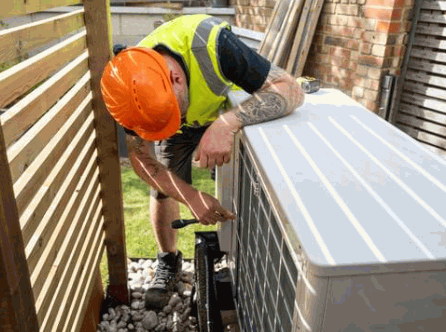
How Much Does It Typically Cost To Install An Air Source Heat Pump?
The typical cost for the installation of an air source heat pump is influenced by several factors, with the average installation expense ranging from £2,000 to £5,000. This variation in cost is dependent on the specific heat pump model, its size, and any additional installation requirements.
It is essential for homeowners to comprehend the cost breakdown in order to effectively prepare for this investment.
Average Cost
The average cost of installing an air source heat pump typically ranges from £3,000 to £5,000, which includes both the necessary equipment and labor for a complete installation. This investment often yields long-term benefits through energy savings and an increase in home value. Air source heat pumps serve as a reliable alternative to traditional heating methods, making them a preferred option for homeowners seeking to lower their energy expenses.
The overall expenses associated with air-source heat pumps can be categorized into several key components:
- Equipment Costs: The heat pump itself generally falls within the range of £1,500 to £3,000, depending on its capacity and brand.
- Installation Labor: Engaging a qualified technician for installation typically adds between £1,000 and £1,500 to the total cost.
- Additional Features: Optional accessories, such as smart thermostats or advanced zoning systems, may incur an additional expense of £200 to £550.
In comparison to traditional heating systems, such as gas or electric furnaces, which can exceed £4,000 solely for installation, air-source heat pumps represent a more cost-effective long-term solution. The efficiency of these heat pumps results in reduced energy consumption, positioning them as both a sustainable choice and a prudent financial decision for many homeowners.
Cost Range
The cost range for installing an air source heat pump can vary significantly, typically falling between £2,000 and £6,000. This variation is influenced by several factors, including brand, size, and specific installation requirements. Homeowners should plan their budgets accordingly to facilitate a seamless installation process.
This price variability can be attributed to several critical considerations that homeowners should assess when planning their investment. Firstly, the selected brand and model can considerably affect the overall costs. The reputation of different brands often results in varying price points, as higher-end models may provide advanced features and efficiencies that justify the higher costs. Additionally, the size of the heat pump required for a particular space is a significant factor; larger homes may necessitate more powerful systems, leading to an increased overall investment. Furthermore, additional installation requirements, such as retrofitting existing systems or upgrading electrical wiring, can contribute to the total cost.
Key factors to consider include:
- Brand reputation
- Model specifics
- Size compatibility
- Installation complexities
Therefore, it is advisable for homeowners to obtain multiple quotes from contractors. This approach not only provides a clearer understanding of the market range but also assists in identifying the best option tailored to their unique needs and circumstances.
Cost Breakdown
Understanding the cost breakdown associated with the installation of an air source heat pump is essential for homeowners to effectively anticipate expenses. This breakdown typically includes the purchase of equipment, labor fees, and necessary modifications or upgrades, such as adjustments to the electrical panel or improvements to insulation. Notably, the installation of an HVAC system, including an air source heat pump, can vary based on specific brand choices like American Standard, Carrier, Goodman, Rheem, and Trane.
A comprehensive understanding of these costs not only facilitates budgeting but also supports knowledge-based decision-making regarding energy efficiency measures. Consideration of factors such as the Heating Seasonal Performance Factor (HSPF) and Seasonal Energy Efficiency Ratio (SEER) can help determine the best heat pump for optimal energy savings.
Several factors contribute to the overall installation costs, including:
- Equipment Costs: This includes the price of the heat pump unit itself, which can vary significantly based on brand, capacity, and efficiency ratings, such as those offered by American Standard, Carrier, Goodman, Rheem, and Trane.
- Labor Costs: Professional installation services often incur additional fees for the skilled labor required, encompassing plumbing and electrical work.
- Additional Fees: Homeowners should be cognizant of potential extra expenses related to necessary adjustments to existing systems or permits mandated by local regulations. Additionally, the cost may vary if special HVAC system components are needed.
It is imperative for homeowners to receive transparent communication from contractors regarding these costs, as this fosters trust and minimizes the risk of unforeseen charges. By requesting a detailed cost breakdown from prospective contractors, homeowners can make more informed decisions and circumvent unexpected financial burdens.
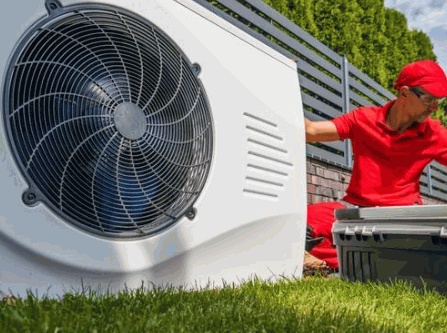
Are There Any Additional Costs To Consider?
When evaluating the installation of an air source heat pump, homeowners should take into account additional costs that may arise, including maintenance costs, operational expenses, and potential financing options to effectively manage the overall investment. For example, programs like the Energy Efficient Home Improvement tax credit can help offset costs.
A comprehensive understanding of these factors can facilitate a smoother transition to this energy-efficient system.
Maintenance Costs
The maintenance costs associated with an air source heat pump are generally lower than those of traditional heating systems; however, homeowners should still allocate a budget for routine inspections, filter replacements, and occasional service calls to ensure optimal performance and longevity. Adopting a comprehensive maintenance plan can also contribute to improved HVAC system efficiency and lower operational costs.
Beyond these standard maintenance tasks, it is important to consider the broader implications of caring for such systems. Regular upkeep can result in significant long-term savings; by enhancing the efficiency of the heat pump, energy costs can be reduced, thereby providing financial relief during peak seasons. Proactively managing maintenance can also help prevent unexpected failures that may lead to higher repair costs.
Routine Maintenance Activities:
- Inspection of the outdoor unit for debris and dirt
- Checking electrical components and connections
Conversely, unforeseen breakdowns can lead to unexpected expenses and disrupt heating during colder months. Therefore, comprehending these dynamics is crucial for making informed decisions regarding investments in repairs versus replacements.
Operating Costs
Operating costs for air-source heat pumps are typically lower than those associated with conventional heating systems, as these pumps utilize energy more efficiently, resulting in substantial energy savings over time. This enhanced efficiency leads to reduced monthly utility bills for homeowners. The higher the SEER and HSPF ratings of the heat pump, the more efficient and cost-effective it becomes.
Several factors contribute to these favorable operating costs, including energy consumption, geographical location, and specifics related to installation. For example, energy consumption is generally lower because air source heat pumps extract heat from the external environment and concentrate it for indoor use, rather than producing heat through combustion. Geographical location affects the British thermal units (BTUs) needed for heating, impacting overall energy use.
- In moderate climates, homeowners may experience savings of up to 50% in heating costs compared to traditional systems.
- Likewise, individuals residing in areas with higher energy prices often realize even greater reductions in expenses due to the efficiency of these pumps.
Engagement in energy efficiency programs may offer additional financial incentives, promoting the adoption of these systems. For instance, rebates and tax credits provided by local governments can significantly offset initial installation costs, thereby enhancing overall savings for homeowners while contributing to a more sustainable environment.
Financing Options
Financing options for the installation of air-source heat pumps can significantly alleviate upfront costs, enabling homeowners to invest in energy-efficient technologies without experiencing financial strain. Various programs and incentives, including tax credits, can further enhance affordability.
It is essential for individuals considering this upgrade to understand the variety of financing solutions available. Many homeowners find that loans specifically designed for energy efficiency improvements can offer manageable monthly payments, facilitating a smoother transition.
Certain utility companies provide:
- Rebates
- Discounted rates
- Incentive programs
These initiatives encourage the adoption of renewable energy systems, effectively reducing the overall investment required. By capitalizing on these financial benefits, homeowners can enhance their property’s energy efficiency while contributing to long-term savings on utility bills.
State and federal tax credits can also play a significant role in offsetting installation costs, providing a greater sense of financial security, and enabling more families to make environmentally-friendly choices. Programs such as the Energy Efficiency Program run by local governments and utility companies can provide additional incentives.
